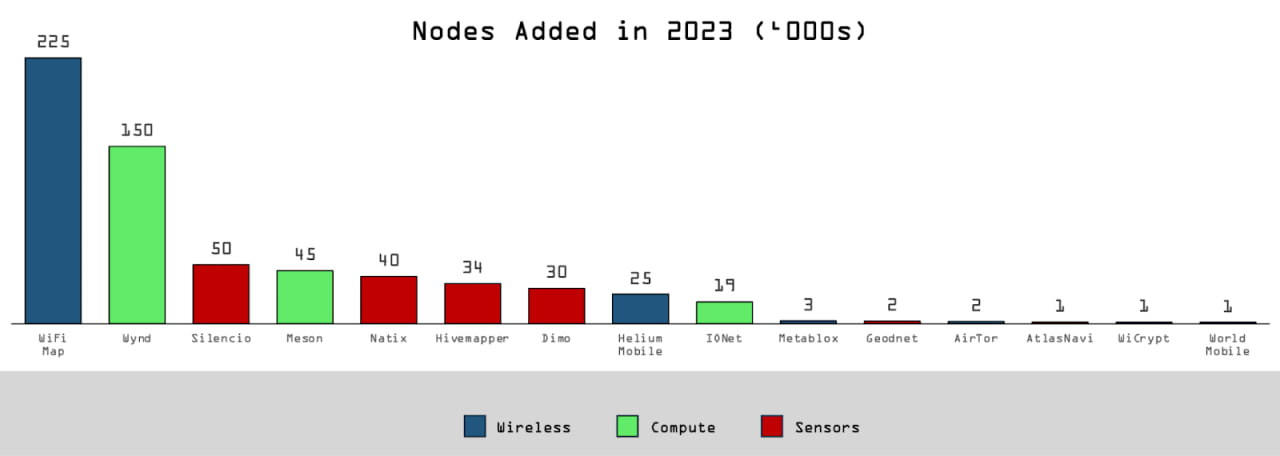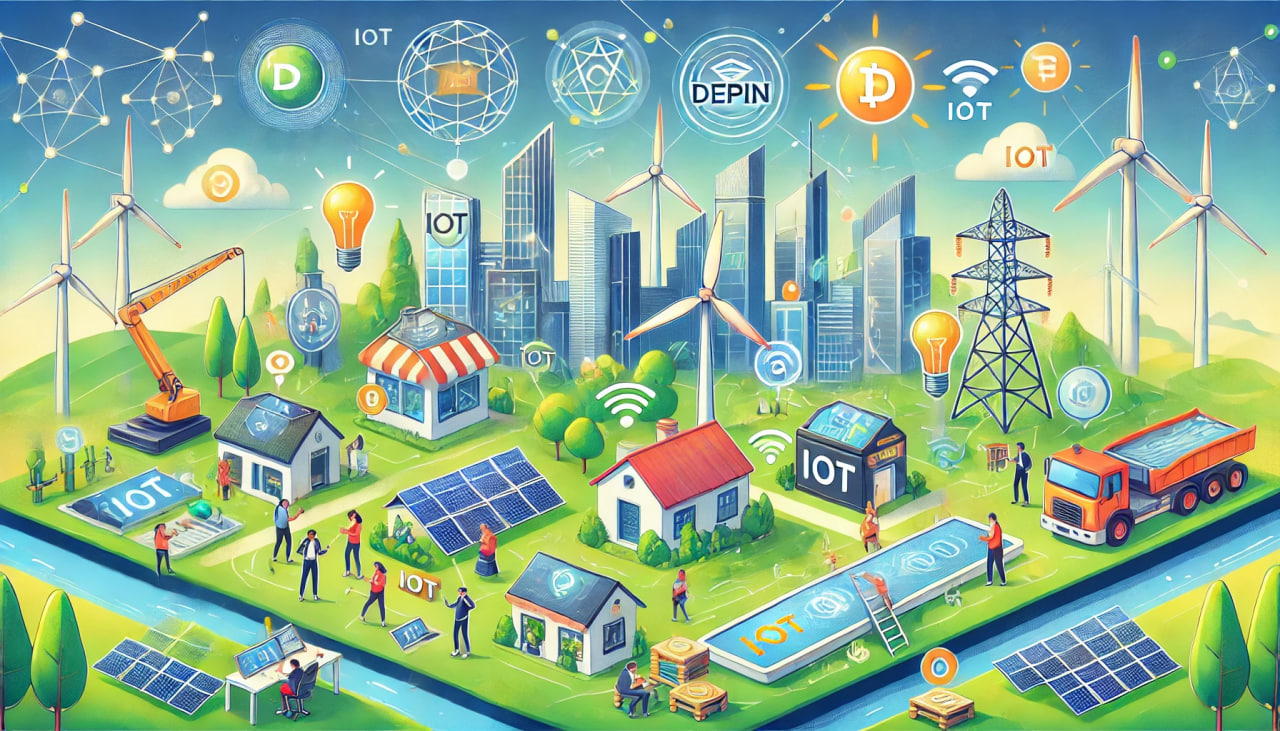In recent years, blockchain has evolved from a specialized technology underpinning cryptocurrencies into a powerful tool with a wide range of applications. Today, its potential is being actively explored not only in the financial sector, but also in various industries, from logistics and supply chains to medicine and government administration.
One promising direction for blockchain use is the creation of decentralized physical infrastructure networks (DePIN). DePIN is not just a technology, it is an opportunity to reimagine infrastructure management, improving its efficiency, transparency, and security. Despite its early stage of development, it already holds the potential for revolutionary transformations across various fields.
- What is DePIN?
- How it works
- Existing DePIN projects
- Advantages and disadvantages
- DePIN: growth prospects
- Conclusion
What is DePIN?
DePIN (Decentralized Physical Infrastructure Networks) is an innovative concept, combining the capabilities of blockchain technology and decentralization principles for the creation, maintenance, development, and operation of physical infrastructure networks.
At the core of DePIN lies the idea of distributed management:
- The community of users and infrastructure operators jointly makes decisions regarding the development and operation of the network.
- Network participants receive rewards in the form of tokens for their contributions to the system, ensuring its decentralized nature.
The idea of using blockchain for real-world infrastructure emerged about ten years ago. However, at that time, it did not have a unified name DePIN. The pioneers in this sector were the developers of Filecoin.
Thanks to an embedded economic incentive mechanism, providers strive to improve their computational power. End-users are attracted by lower fees compared to services offered by large corporations.
How it works
DePIN combines blockchain technology with physical infrastructure, creating a unique synergy between the virtual and real worlds. Here is how it works.
The provider manages a real-world object, while the middleware processes connections between the distributed ledger and physical infrastructure. This software collects data on the activity of each individual object and transmits information to the decentralized network, ensuring data transparency and accuracy.
The blockchain protocol acts as an administrator, distributing demand among providers and calculating rewards in the form of tokens based on this demand. This incentivizes providers to make as much unused resource available as possible, increasing the overall system efficiency.
| Category | Description |
|---|---|
| Physical Resource Networks (PRN) | Resources that are highly dependent on geolocation and are not interchangeable. The services of such projects are localized and usually related to mobile technologies or energy. |
| Digital Resource Networks (DRN) | Providers of such networks offer computing power or storage space. These resources are not tied to a specific location. |
DePIN projects are actively working in various industries, such as:
- wireless communication (Helium);
- cloud services (Arweave);
- power grids (Arcreen);
- mobile technologies (Dimo);
- computing networks (Nunet);
- geolocation services (Hivemapper);
- healthcare (Healthblocks).
DePIN uses blockchain to decentralize network management, and its application spans various fields, including energy, supply chains, telecommunications, data storage, transportation, and real estate.
For example, in the energy sector, decentralized networks can facilitate peer-to-peer energy trading, where all interactions are recorded in a transparent blockchain. Smart contracts can automate these transactions, increasing the efficiency and spread of renewable energy sources. In some cases, users can earn cryptocurrency rewards for participating and supporting network development.
Existing DePIN projects
Filecoin
Filecoin solves the need for decentralized data storage solutions using blockchain technology. With Filecoin, users can rent out unused disk space in exchange for cryptocurrency. This decentralized network ensures data security, redundancy, and availability through a distributed network of storage providers.
Render
Render is a DePIN project that offers decentralized rendering solutions using GPU power. Render connects node operators looking to monetize unused GPU resources with artists who need to scale their applications and 3D rendering. Additionally, Render provides a platform for artists and developers to create various services and applications.
The Graph
The Graph is a decentralized protocol designed for indexing and querying blockchain data. It organizes data and makes it accessible to everyone. With Graph Explorer, developers can search, find, and publish any public data necessary for creating decentralized applications (DApp).
Helium
Helium is a decentralized wireless network that provides internet access at a lower cost than some providers in countries like the US and Canada.
Data transmission is carried out through access points using Helium LongFi technology. Node operators (miners) earn HNT tokens, while subscribers receive MOBILE tokens, which they can use to extend their plans.
At the time of writing, the number of access points exceeded 984,900 units. Nodes operate in more than 170 countries, with the largest number located in the US and European countries.
Advantages and disadvantages
Decentralized Physical Infrastructure Networks (DePIN) represent a new paradigm of managing and operating infrastructure assets, based on blockchain and decentralization principles. This innovative concept promises several potential benefits, such as increased efficiency, transparency, accessibility, and sustainability of infrastructure. However, along with the advantages, there are also significant disadvantages to consider.
| Pros of DePIN | Cons of DePIN |
|---|---|
| Increased efficiency and transparency of systems | Vulnerability to hacks and errors |
| Equal opportunities for all participants | High token volatility |
| Ability to scale horizontally | Technical knowledge required to support decentralized infrastructure |
| Affordable and democratic pricing model | Lack of industry regulation, which may facilitate illegal use of DePIN projects |
| Regular passive income for participants | Possibility of being used for illegal content storage |
Overall, DePIN represents an attractive and promising technology that can have a significant impact on the future of infrastructure. Despite existing challenges, DePIN has the potential to become a real solution to many problems.
DePIN: growth prospects
In 2023, the DePIN ecosystem grew significantly, with over 650 projects, according to analysts at Messari. During the same period, the number of nodes in infrastructure projects increased by 600,000.

Lex Sokolin, founder of Generative Ventures, predicts a close integration of DePIN systems with artificial intelligence:
Messari has identified key trends in the development of DePIN for 2024. Experts believe that the mass adoption of projects will be supported by meme tokens. As an example, they cited the BONK airdrop for Solana Saga smartphone users.
Analysts also note that Asia has the greatest potential for rapid development and implementation of decentralized infrastructure projects. They expect that from 2024 to 2025, some of the most significant projects in this sector will be created here.
Conclusion
The first developments in the field of DePIN began appearing about ten years ago. Since then, the number of projects in this direction has grown significantly.
According to Messari, the sector's capitalization exceeds $20 billion, excluding RWA and blockchain oracles. However, even among participants in the cryptocurrency industry, DePIN projects are not yet widely popular, let alone the mass adoption of this concept.
The implementation of decentralized infrastructure may take time, as DePIN faces several unresolved issues. Nevertheless, experts are confident that this system will play a key role in shaping the future and has the potential to change the principles of physical infrastructure functioning.





